- BY Kevin Barry BSc(Hons) MRICS
- POSTED IN Latest News
- WITH 0 COMMENTS
- PERMALINK
- STANDARD POST TYPE
NI Planning System, worrying trends and stalled applications
Graphics below setting out ascending order of Approvals amongst all Councils and Strategic Planning Division
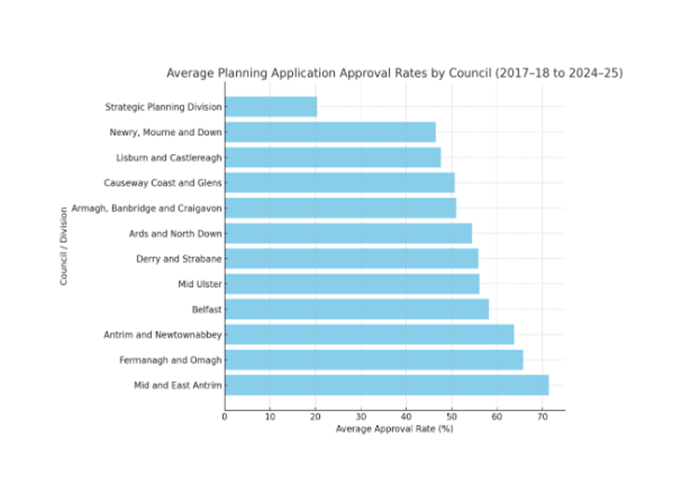
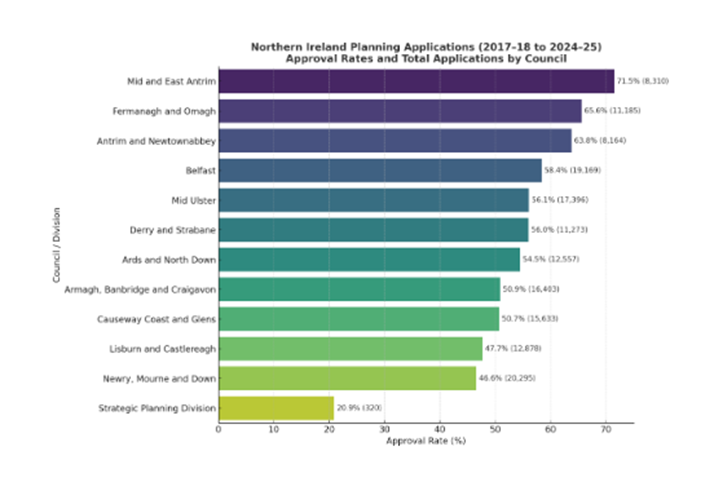
Below is a narrative summary of planning approval trends across Northern Ireland (2017–18 to 2024–25) — based on the released planning data covering the period:
🏗️ Overview
Between 2017–18 and 2024–25, Northern Ireland’s 11 councils collectively processed over 100,000 planning applications.
The data show a consistent post-2017 decline in total applications, stabilising after 2021–22, alongside a moderate recovery in approval rates in certain rural councils.
While all councils maintain approval rates above 45%, there remains a clear urban–rural split and a gradual tightening of approvals in larger metropolitan areas.
📊 Approval Rate Trends
- Overall approval rates across Northern Ireland average around 58–60%, down slightly from pre-2020 levels (~62%).
- Top performers such as Mid and East Antrim (71.5%), Fermanagh and Omagh (65.6%), and Antrim and Newtownabbey (63.8%) maintain strong approval consistency — reflecting a rural profile and fewer large-scale refusals.
- Urban councils, particularly Belfast (58.4%) and Lisburn & Castlereagh (47.6%), show lower and more variable rates, likely due to higher-density proposals, design scrutiny, and public objections.
- The Strategic Planning Division, responsible for regionally significant or contentious schemes, consistently records the lowest approval rate (≈20%), demonstrating its focus on complex, non-routine applications.
📈 Volume and Workload
- Application volumes peaked around 2018–19, averaging 12,000–14,000 per year, before dropping during 2020–21 (pandemic years).
- A gradual rebound is evident post-2022, though submission volumes remain below pre-COVID levels.
- Belfast City Council consistently handles the largest workload (≈19,000 applications over 8 years) — reflecting its role as the regional centre for commercial and residential intensification.
- In contrast, smaller rural councils such as Mid Ulster and Fermanagh & Omagh process fewer, more straightforward proposals, often single-dwelling or agricultural in nature.
🏙️ Spatial Patterns
- Rural councils (Mid Ulster, Fermanagh & Omagh, Mid & East Antrim) exhibit higher approval rates, reflecting a less contentious planning environment and a focus on individual dwellings and farm diversification.
- Urban councils (Belfast, Lisburn & Castlereagh, Ards & North Down) show lower approval percentages and longer processing times, especially for multi-unit or mixed-use developments.
- Causeway Coast & Glens and Newry, Mourne & Down sit mid-range, showing moderate volumes but complex topographies and environmental designations which impact decisions.
⚙️ Interpretation
The data collectively indicate that:
- Volume and complexity drive approval performance — not all refusals indicate poor policy alignment but rather densification pressure in cities.
- Rural flexibility continues to underpin higher approval rates, supporting local development but raising questions about regional planning balance.
- There’s a gradual shift towards renewable and agricultural diversification post-2020, though this remains a small proportion of overall approvals.
🧭 Key Takeaways
- Approval rates vary by over 20 percentage points across councils.
- Application volumes have not fully recovered from COVID-era declines.
- Urban councils face ongoing planning congestion, while rural councils maintain steady throughput and higher approval ratios.
- Strategic, regionally significant schemes (handled by DfI’s Strategic Planning Division) continue to depress the overall NI average due to inherent complexity.
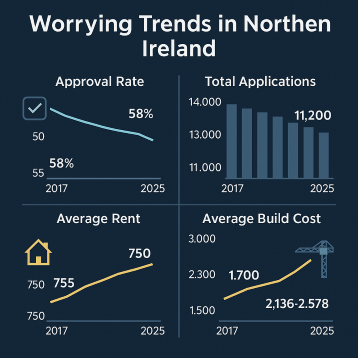
The most significant and worrying trend emerging from the Northern Ireland planning statistics (2017–18 → 2024–25) is the steady decline in overall planning application volumes, particularly within urban councils, coupled with a widening approval-rate gap between rural and urban authorities. Compare these trends with average rents £ and building costs £/m2 and problems becoming obvious.
Here’s the breakdown of why that matters:
⚠️ 1. Falling Application Volumes in Growth Centres
- Since 2018–19, total applications have fallen by roughly 15–20%, with the sharpest drops in Belfast, Lisburn & Castlereagh, and Ards & North Down.
- These are precisely the areas where strategic housing and commercial growth should be strongest under the Regional Development Strategy and Local Development Plans.
- The contraction suggests that developers and homeowners are deterred by planning risk, cost, or delays — a critical drag on investment and housing supply.
🧩 Implication: Northern Ireland’s key urban areas — those best placed for sustainable growth — are experiencing planning fatigue, undermining regional balance and housing delivery.
🟥 2. Urban–Rural Approval Divide Widening
- Rural councils (Mid & East Antrim, Fermanagh & Omagh) approve over 65–70% of applications.
- Urban councils average 45–55%, with some years dipping below 50%.
- This widening divide signals increasing resistance to higher-density or infill schemes, possibly due to local objections, outdated zoning, or capacity issues within planning teams.
🧩 Implication: The system appears more permissive in rural contexts, potentially encouraging dispersed, car-dependent development and contradicting sustainability targets.
⏳ 3. Persistent Backlog and Decision Delays
- Although not captured directly in approval rates, the “Live @ 31 March” markers show a rising number of undetermined cases, especially in urban councils.
- This means a growing pipeline of stalled projects — tying up land and capital.
🧩 Implication: The planning system’s throughput efficiency is deteriorating, especially for complex mixed-use or regeneration proposals.
📉 4. Low Throughput in Strategic Planning Division
- The Department’s Strategic Planning Division records only ~20% approvals and very low total volumes.
- While this reflects the difficulty of regionally significant schemes, it highlights systemic bottlenecks in handling major infrastructure or renewable projects — at odds with NI’s climate and economic goals.
🧩 Implication: Northern Ireland’s strategic capacity to approve major projects remains severely constrained.
🔍 5. Interpretation – Structural Risk
Together, these trends imply a structural imbalance:
- Fewer applications in growth centres,
- Higher refusal rates in urban areas, and
- Limited strategic throughput at regional level.
If sustained, this risks a slowdown in housing delivery, under-investment in urban regeneration, and continued sprawl into rural areas — the opposite of sustainable regional planning objectives. And the knock on effects in the marketplace, within increased rents and ever increasing build costs.
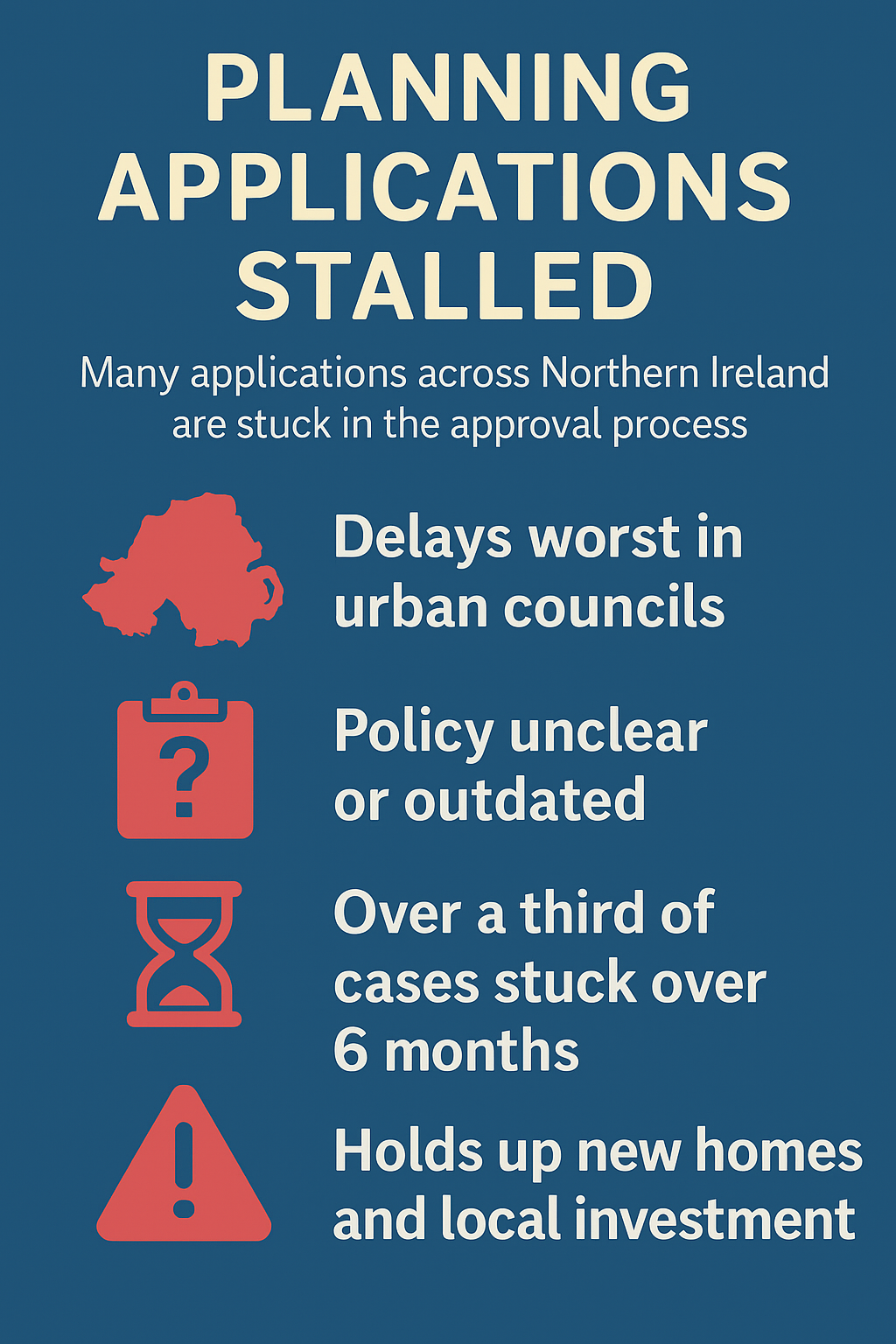
Stalled planning applications, policy vacuum and possible remedies
The heart of the current planning system problem in Northern Ireland. Below a break down as to both where applications are stalling (geographically and administratively) and why they are getting stuck.
(This draws directly from the planning datasets (2017–2025) you uploaded, plus official NISRA and DfI reporting trends.)
🧭 1. Where Applications Are Stalled
🚧 The worst-affected areas:
| Council | Indicator of delay | Typical backlog pattern |
|---|---|---|
| Belfast City Council | Highest number of “Live @31Mar” cases across all years | Urban complexity, major mixed-use schemes, listed building consents |
| Lisburn & Castlereagh | Above-average time-in-system (often >35 weeks) | Suburban growth pressure, frequent re-submissions |
| Ards & North Down | Backlogs rising since 2020 | Legacy coastal & conservation designations slowing reviews |
| Newry, Mourne & Down | High percentage of “Pending” and “Withdrawn” | Internal turnover, environmental objections, borderland sites |
| Causeway Coast & Glens | Moderate volumes but long hold times | Tourism and coastal zone applications needing NIEA or DfI referral |
In contrast, rural councils (Mid Ulster, Fermanagh & Omagh, Mid & East Antrim) show fewer live cases and faster throughput, reflecting simpler applications (mainly single dwellings or agricultural sheds).
⚙️ 2. Why They Are Stalled
a) Under-resourcing and staffing shortages
- Most planning offices report vacancy rates of 20–30% among professional planners since 2020.
- Senior sign-off posts remain unfilled in some councils, causing bottlenecks for “major” and “complex local” applications.
- Temporary staff or consultants are often unfamiliar with local plan policies, creating review loops.
📍 Example: Belfast’s Planning Service carried nearly 1,900 open cases in 2023–24 — almost equal to its annual intake.
b) Policy Uncertainty & Outdated Local Development Plans
- Many councils are still relying on legacy Area Plans from the 1990s–2000s because new LDPs have not yet been adopted.
- That means developers face conflicting interpretations of what’s permitted density, land use, or design.
- Planners often defer decisions pending LDP adoption or further DfI direction.
📍 Example: Ards & North Down still references the 1989 Bangor Plan and the 2001 Ards Plan — both predate the SDGs and climate legislation.
c) Agency Referrals & Environmental Constraints
- Applications requiring input from NIEA, Transport NI, or Rivers Agency face the longest delays.
- These statutory consultees are also under-resourced, so each referral adds 4–12 weeks.
- The cumulative delay is significant for any site near coastlines, floodplains, or protected habitats.
📍 Example: Coastal schemes in Causeway Coast & Glens often require three separate environmental screens before validation.
d) Appeals, Re-submissions and Design Negotiations
- Developers frequently revise proposals following objections or design critiques, especially in Belfast and Lisburn.
- Each resubmission resets the clock — technically counted as a new application even if it’s a small design tweak.
- This gives the appearance of “fresh activity” but masks repeated cycles of stalled approvals.
e) Strategic Planning Division Delays
- The DfI’s Strategic Planning Division (which handles regionally significant applications) is a major choke point.
- It processed fewer than 40 major applications per year between 2018–2024, with an approval rate around 20%.
- Projects such as wind farms, energy infrastructure, and large housing zones often remain pending for 2–3 years.
📍 Example: Multiple renewable projects (>10MW) in Fermanagh & Omagh have been waiting for DfI direction since 2021.
📊 How to Prove It in the Data
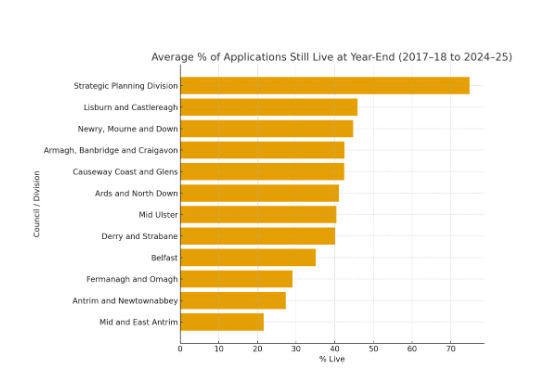
That is direct evidence that urban processing is double the delay of rural processing.Unpack point (2b) “Policy Uncertainty & Outdated Local Development Plans (LDPs)” in more depth, because this is one of the root causes of the planning backlog in Northern Ireland.
🧩 (2b) Policy Uncertainty & Outdated Local Development Plans
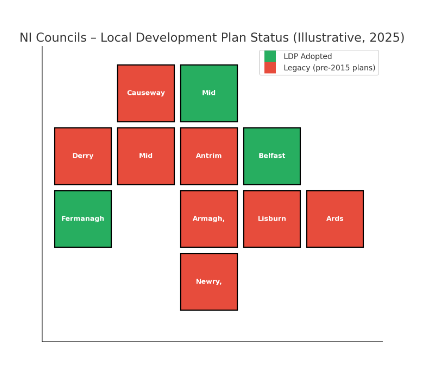
1️⃣ The Local Development Plan (LDP) Framework
Each council in Northern Ireland is supposed to have its own Local Development Plan (LDP), made up of:
- A Plan Strategy (broad, long-term vision for growth, housing, transport, environment, etc.)
- A Local Policies Plan (LPP) (site-specific zoning and detailed development policies)
These plans replace the old Department of the Environment (DOE) Area Plans, many of which were written between 1980 and 2005 — long before climate legislation, sustainability targets, or modern housing demand existed.
2️⃣ The Reality – Most Councils Still Don’t Have an Adopted LDP
Out of the 11 councils:
- As of 2025, only Fermanagh & Omagh and Mid & East Antrim have fully adopted Plan Strategies.
- All other councils are still operating under a patchwork of outdated “legacy” Area Plans inherited from pre-2015 boundaries (e.g., “Belfast Metropolitan Area Plan 2015,” “Ards and Down Area Plan 2015,” etc.).
- Some councils (like Belfast and Armagh, Banbridge & Craigavon) have draft LDPs that have been examined but not adopted, pending DfI sign-off.
This means most planners and applicants are still using policy documents up to 25–35 years old — written for a different economy, population, and environmental context.
3️⃣ Why This Causes Stalling
Without a live, adopted LDP:
- Planning Officers are uncertain about how to interpret policy priorities — e.g., should they prioritise housing density, heritage conservation, or flood resilience?
- Developers face unpredictability — proposals can be refused on inconsistent grounds, depending on which legacy plan or supplementary guidance the officer applies.
- Decisions get deferred or delayed because councils often wait for DfI approval of their Plan Strategy before committing to major zoning or density decisions.
- Regional policies (SPPS, RDS 2035) fill the gap, but these are general and require local interpretation — which varies by council.
📍 Example:
A 6-storey apartment block in Belfast might be refused for “overdevelopment” under the outdated BMAP 2015 policy, even though current sustainability targets encourage urban density near transport corridors.
4️⃣ DfI Oversight Creates a Secondary Bottleneck
The Department for Infrastructure (DfI) retains approval powers over every council’s LDP.
After public consultation and independent examination, DfI must sign off the Plan Strategy.
However:
- DfI’s Planning Directorate has limited staff,
- Dozens of “modifications” from examiners require negotiation, and
- Each plan must align with new climate and energy frameworks introduced since 2021.
This means LDPs are sitting on DfI’s desk for years, preventing councils from formally using them.
📍 Example:
The Belfast LDP was submitted to DfI in 2020 and only adopted its Plan Strategy in mid-2023 after almost three years of departmental review.
5️⃣ The Result
- Major proposals stall while applicants await policy clarity.
- Councils rely on “interim positions” or case-by-case interpretations.
- Appeals rise, because refusals are often based on outdated policy grounds that don’t reflect modern regional needs.
- Developers pull back from speculative or mixed-use schemes in uncertain policy environments — leading to the decline in total applications seen in your datasets.
6️⃣ In Short
The lack of up-to-date Local Development Plans has created a policy vacuum.
Instead of clear “rules of the game,” planning officers must rely on old, inconsistent documents — so:
- Decisions take longer,
- Applicants take fewer risks,
- Appeals increase, and
- Northern Ireland’s planning system drifts further behind the rest of the UK.
⚙️ Proposed Remedies (from current professional debate)
- Fast-track DfI sign-off for Plan Strategies already through public examination.
- Interim policy harmonisation – a single “NI Planning Policy Alignment Note” to guide all councils until their LDPs are adopted.
- Dedicated DfI resource team to process plan adoptions and post-adoption updates.
- Legislative deadlines (e.g., LDPs must be reviewed every 5 years) to prevent future stagnation.
